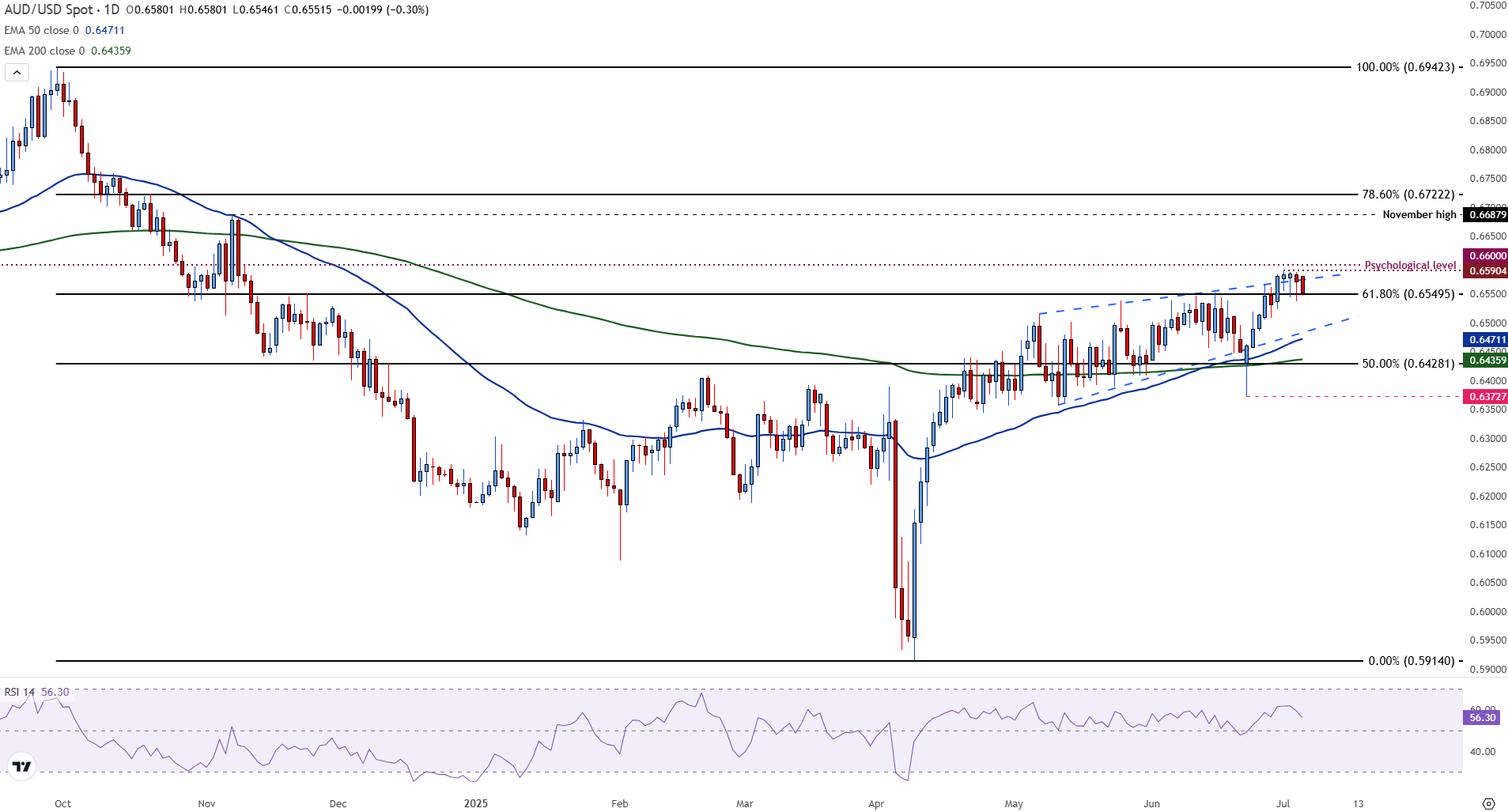Created
: 2025.07.05














![]() 2025.07.05 05:15
2025.07.05 05:15
The Australian Dollar (AUD) weakened against the US Dollar (USD) on Friday amid a low-volume trading session and a risk-off tone ahead of US President Donald Trump's July 9 tariff deadline.
At the time of writing, AUD/USD is hovering above 0.6550, with intraday losses of 0.30%.
The closure of US financial markets for Independence Day led to lighter trading volumes, resulting in subdued volatility and a more corrective tone across currency markets.
Adding to the bearish bias was weaker-than-expected Australian trade data. Figures released on Thursday showed a 2.7% decline in exports for May, resulting in a narrower trade surplus.
A risk-off tone was visible on Friday ahead of President Trump's July 9 tariff deadline.
Trump's threat to impose tariffs of 10% to 70% on multiple countries and dictate trade terms has reignited global trade fears, prompting safe-haven flows and pressuring risk-sensitive currencies.
At the same time, expectations are mounting that the Reserve Bank of Australia (RBA) will continue easing monetary policy.
According to a Reuters survey released on Friday, a strong majority of 31 out of 37 economists expect the central bank to implement a third consecutive 25-basis-point rate cut on Tuesday. This would bring the official cash rate down to 3.60%.
This anticipated move reflects the RBA's response to moderating inflation and a slowing domestic economy. Meanwhile, the Federal Reserve (Fed) has maintained interest rates within the 4.25% to 4.50% range, providing some support to the US Dollar.
From a technical perspective, AUD/USD remains within the confines of a rising wedge pattern on the daily chart, a structure that often signals potential trend exhaustion. Recent price action has struggled to breach the 0.6590 level, with multiple failed attempts to clear this barrier just beneath the key psychological resistance at 0.6600. This hesitation has led to a mild pullback, reflecting market indecision as bullish momentum starts to fade.
Despite the pullback, the broader trend remains constructive. The pair continues to trade above both the 50-day Exponential Moving Average (EMA), currently at 0.6471, and the 200-day EMA at 0.6436. This highlights the underlying bullish structure and suggests that buyers remain in control on a medium-term basis.
AUD/USD daily chart

Momentum indicators, however, are starting to show early signs of fatigue. The Relative Strength Index (RSI) has eased to around 56, down from prior highs, indicating weakening momentum while still holding above the neutral 50 level. This suggests that the bullish bias is still intact, but momentum is softening.
A confirmed breakout above 0.6600 could trigger renewed upside, potentially opening the door to the 78.6% Fibonacci retracement of the September-April decline at 0.6722.
On the downside, a rejection at current levels may lead to a deeper pullback, with initial support seen at the 61.8% Fibonacci level near 0.6550. This may be followed by stronger support near the 50% retracement at 0.6428, which closely aligns with the 200-day EMA, adding to its technical significance.
In the world of financial jargon the two widely used terms "risk-on" and "risk off'' refer to the level of risk that investors are willing to stomach during the period referenced. In a "risk-on" market, investors are optimistic about the future and more willing to buy risky assets. In a "risk-off" market investors start to 'play it safe' because they are worried about the future, and therefore buy less risky assets that are more certain of bringing a return, even if it is relatively modest.
Typically, during periods of "risk-on", stock markets will rise, most commodities - except Gold - will also gain in value, since they benefit from a positive growth outlook. The currencies of nations that are heavy commodity exporters strengthen because of increased demand, and Cryptocurrencies rise. In a "risk-off" market, Bonds go up - especially major government Bonds - Gold shines, and safe-haven currencies such as the Japanese Yen, Swiss Franc and US Dollar all benefit.
The Australian Dollar (AUD), the Canadian Dollar (CAD), the New Zealand Dollar (NZD) and minor FX like the Ruble (RUB) and the South African Rand (ZAR), all tend to rise in markets that are "risk-on". This is because the economies of these currencies are heavily reliant on commodity exports for growth, and commodities tend to rise in price during risk-on periods. This is because investors foresee greater demand for raw materials in the future due to heightened economic activity.
The major currencies that tend to rise during periods of "risk-off" are the US Dollar (USD), the Japanese Yen (JPY) and the Swiss Franc (CHF). The US Dollar, because it is the world's reserve currency, and because in times of crisis investors buy US government debt, which is seen as safe because the largest economy in the world is unlikely to default. The Yen, from increased demand for Japanese government bonds, because a high proportion are held by domestic investors who are unlikely to dump them - even in a crisis. The Swiss Franc, because strict Swiss banking laws offer investors enhanced capital protection.
![]()
Created
: 2025.07.05
![]()
Last updated
: 2025.07.05

FXStreet is a forex information website, delivering market analysis and news articles 24/7.
It features a number of articles contributed by well-known analysts, in addition to the ones by its editorial team.
Founded in 2000 by Francesc Riverola, a Spanish economist, it has grown to become a world-renowned information website.
We hope you find this article useful. Any comments or suggestions will be greatly appreciated.
We are also looking for writers with extensive experience in forex and crypto to join us.
please contact us at [email protected].
Disclaimer:
All information and content provided on this website is provided for informational purposes only and is not intended to solicit any investment. Although all efforts are made in order to ensure that the information is correct, no guarantee is provided for the accuracy of any content on this website. Any decision made shall be the responsibility of the investor and Myforex does not take any responsibility whatsoever regarding the use of any information provided herein.
The content provided on this website belongs to Myforex and, where stated, the relevant licensors. All rights are reserved by Myforex and the relevant licensors, and no content of this website, whether in full or in part, shall be copied or displayed elsewhere without the explicit written permission of the relevant copyright holder. If you wish to use any part of the content provided on this website, please ensure that you contact Myforex.
Myforex uses cookies to improve the convenience and functionality of this website. This website may include cookies not only by us but also by third parties (advertisers, log analysts, etc.) for the purpose of tracking the activities of users. Cookie policy